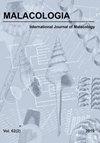Low Genetic Diversity in a Potential (Glacial) Relict: The Rocky Mountain Capshell, Acroloxus coloradensis (Henderson, 1930) (Gastropoda: Acroloxidae)
IF 1
4区 生物学
Q4 ZOOLOGY
引用次数: 0
Abstract
ABSTRACT Acroloxus coloradensis is a rare and potentially glacial relict freshwater limpet species endemic to North America. However, despite its remarkable patchy distribution across the continent, only very few genetic data is available for the different populations. Here, we sequenced two standard barcoding markers for individuals from five populations to shed some light on the genetic population structure of this species. Overall, our genetic analyses revealed low genetic variation and identified three and two haplotypes for COI and 16S rRNA, respectively. The three Rocky Mountain populations differed only slightly for COI and shared the same haplotype for 16S rRNA. For both markers, no genetic variation was detected within the two populations sampled in Québec. The present genetic data suggest that A. coloradensis is indeed a relict species and that the distribution of this species was strongly affected by the last glacial retreat in North America.潜在(冰川)遗迹的低遗传多样性:落基山盖壳,Acroloxus coloradensis (Henderson, 1930)(腹足目:Acroloxidae)
摘要:科罗拉多Acroloxus coloradensis是一种罕见的、潜在的冰川遗迹淡水帽贝物种,原产于北美洲。然而,尽管它在整个大陆的分布非常不均匀,但对于不同的种群,只有很少的基因数据可用。在这里,我们对来自五个种群的个体的两个标准条形码标记进行了测序,以揭示该物种的遗传种群结构。总体而言,我们的遗传分析显示遗传变异较低,并分别鉴定了COI和16S rRNA的三个和两个单倍型。三个落基山脉种群的COI仅略有不同,16S rRNA具有相同的单倍型。对于这两个标记,在魁北克采样的两个种群中均未检测到遗传变异。目前的遗传数据表明,A.coloradensis确实是一个残余物种,该物种的分布受到北美最后一次冰川退缩的强烈影响。
本文章由计算机程序翻译,如有差异,请以英文原文为准。
求助全文
约1分钟内获得全文
求助全文
来源期刊

Malacologia
生物-动物学
CiteScore
2.00
自引率
0.00%
发文量
15
审稿时长
3 months
期刊介绍:
Malacologia publishes papers on all groups of the Mollusca. Malacologia specializes in publishing long papers and monographic treatments. Complete data are especially appreciated. Papers must be of interest to an international readership. Papers in systematics, ecology, population ecology, genetics, molecular genetics, evolution and phylogenetic treatments are especially welcomed. Also welcomed are letters to the editor involving papers published or issues of import to science of the day.
 求助内容:
求助内容: 应助结果提醒方式:
应助结果提醒方式:


